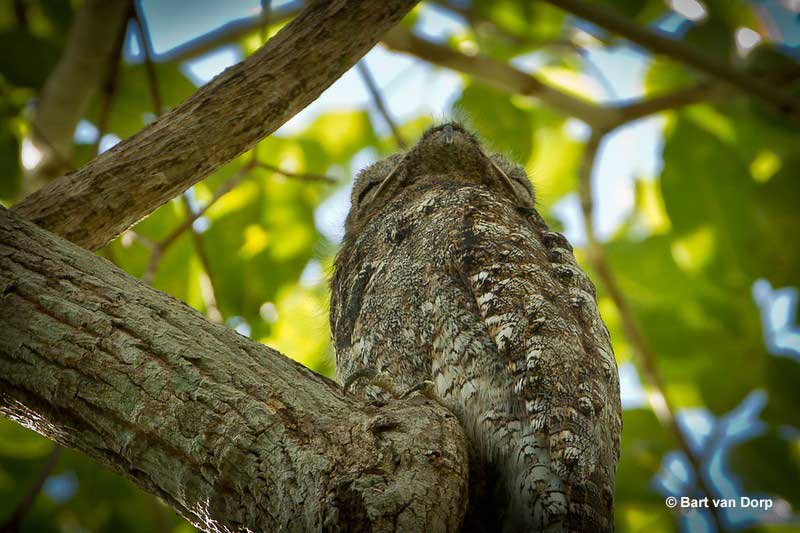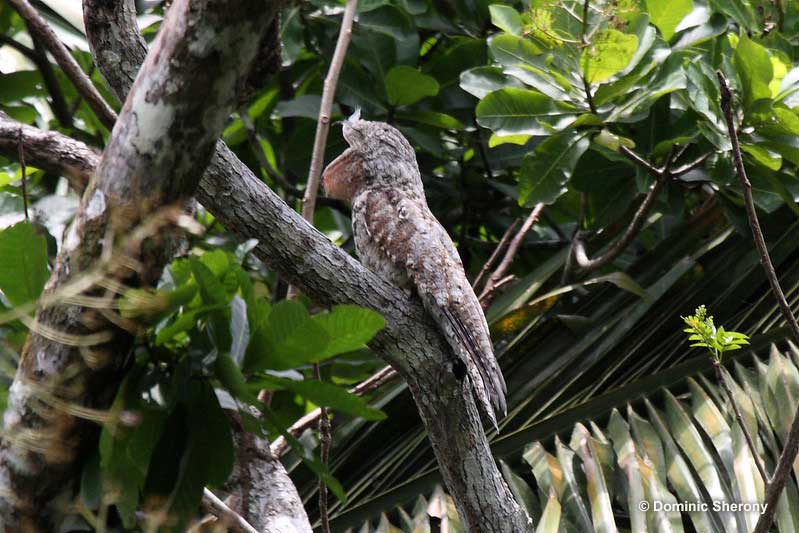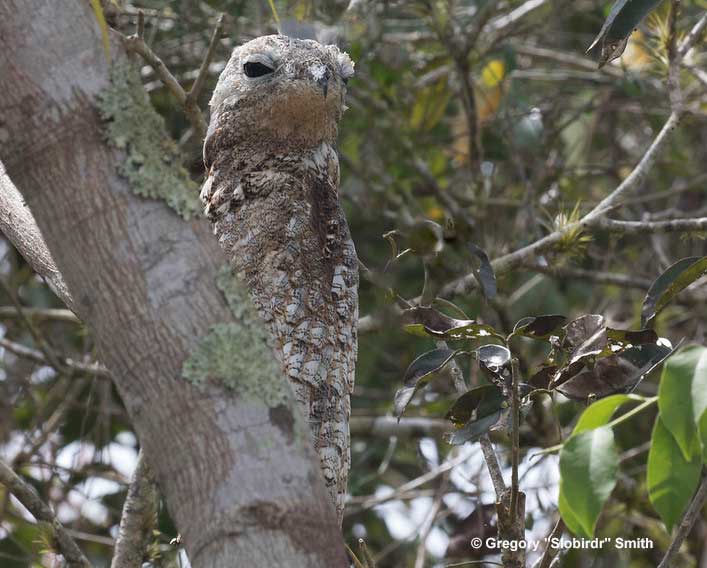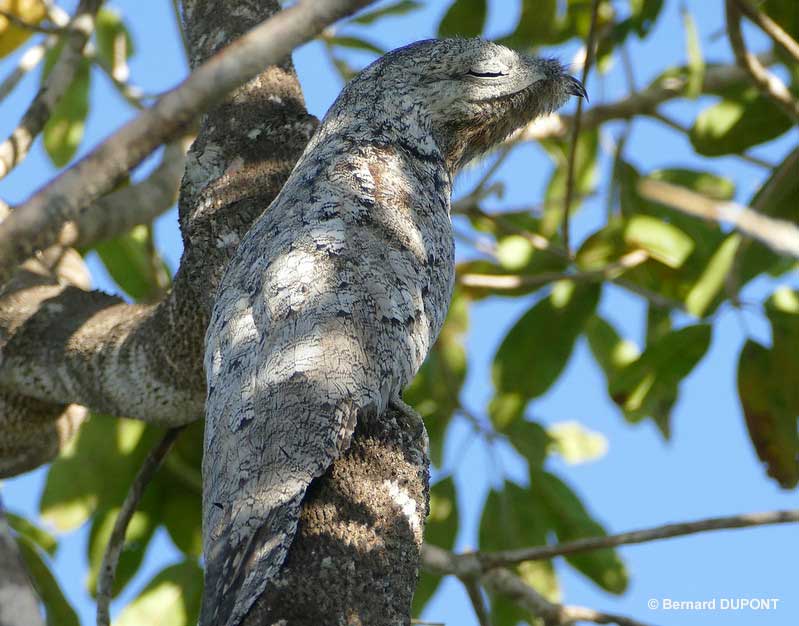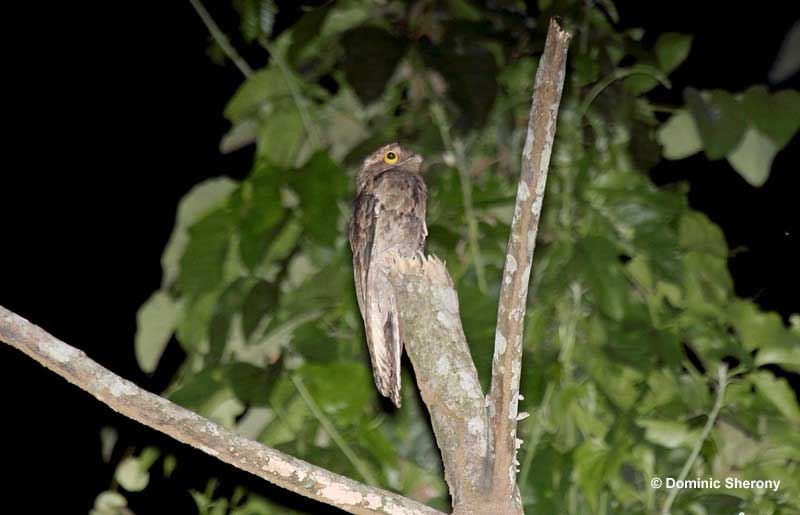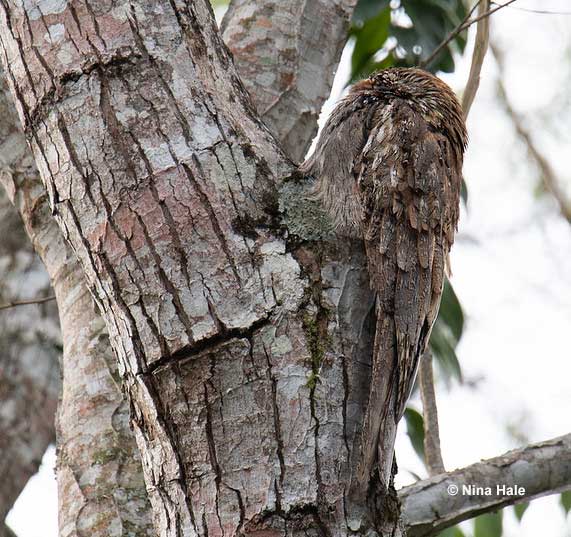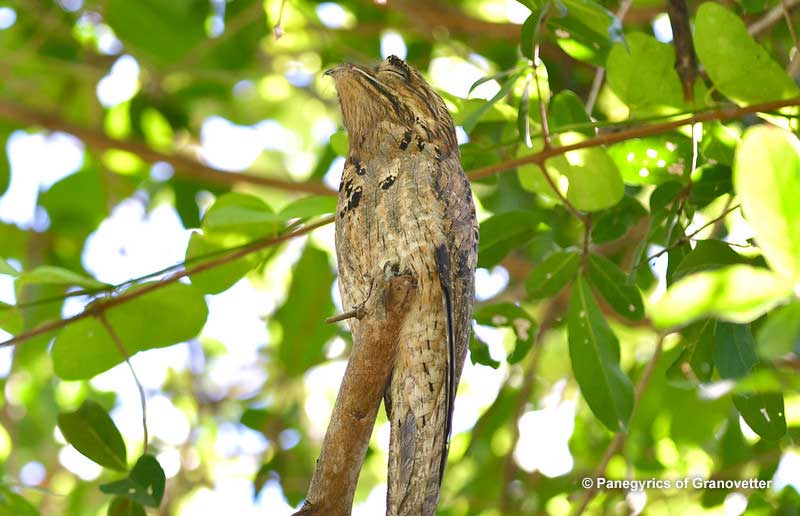The Great Potoo (Nyctibius grandis), also known as the ghost bird, is a distinctive species found in Central and South America.
The species is known for its cryptic plumage, unusually large gaping mouth, and haunting calls.
They are primarily nocturnal birds and are often active during dusk and dawn, remaining camouflaged and stationary during the day on tree branches. These birds are shy so make your first introductions here!
On this page
Identification
Great Potoos have a unique appearance that aids in their camouflage. They have large heads with large, dark eyes with yellowish irises that enable them to see well in low light conditions. Their plumage is mottled with shades of gray, brown, and black, helping them blend seamlessly with tree bark.
They have a stout body which measures 18-23 inches long, a short neck, and a large mouth. Their bill is relatively short and broad, adapted for catching insects on the wing. In flight, their rounded, elliptical wings and long tails help maneuver and hunt.
Unlike some bird species, where males and females might have different plumage colors or patterns, the Great Potoo lacks such distinctive sexual dimorphism.
Male and female Great Potoos appear identical, which makes it impossible to distinguish between the sexes based on physical traits alone.
Juvenile Great Potoos often have a slightly different appearance compared to adults. They tend to be fluffier due to their down feathers. Younglings also have paler plumage, shorter bills and tails, and a more petite build.
Food
The Great Potoo’s diet consists primarily of nocturnal flying insects, such as moths, katydids, beetles, and other similar critters. Sometimes they even catch bats.
They hunt at night and use their ability to camouflage to their advantage. Great Potoos sit and wait on a lower and exposed branch, remaining motionless and inconspicuous thanks to their plumage.
When they spot prey, they take flight, capture it, and return to the same perch to consume it. They seem to use the same branch from night to night.
Nesting and Eggs
The time of the nesting season varies from location to location, but it generally coincides with the wet season. The Great Potoo nest is a deeper notch in a larger branch on a roosting tree and at least 33 feet above the ground.
These birds are monogamous breeders. The Great Potoo’s egg is 2 inches long and 1.5 inches wide, white with some dark spotting.
Females only lay one per clutch and it is unknown how long exactly the incubation period lasts. However, we do know that during that time, only one parent is present in the nest. After the eggs hatch, both parents hunt at night and bring back prey items to provide the young.
Great Potoo chicks fledge at around 55 days after hatching. About one month after hatching, the chicks begin venturing out of the nest to explore the nesting branch.
Around six weeks after hatching, adults don’t return to the nest anymore during the daytime. Instead, the parents only meet with their offspring after dark, likely to feed them and teach them to hunt.
The young potoos reach independence at around two months after hatching.
Vocalizations
Great Potoos communicate through a range of vocalizations that are typically characterized by their eerie and haunting quality. They mostly communicate at night, presumably to announce their territories to others of their species.
The more common and haunting Great Potoo call is the eerie whoap. They can utter it both while perched and in flight, and it sounds like a person moaning.
A somewhat rarer call can be described as the croaking of a frog, a deep baaaao. They may also make clicking sounds.
Current Situation
Great Potoos range throughout the neotropical regions from southern Mexico through most of Central America to South America as far as Bolivia. They are solitary birds and prefer to inhabit forested habitats, such as rainforests, and dense lowland forests.
However, you can also meet them in grasslands, foothills, or even meadows as long as there are suitable trees nearby.
Although rather uncommon to encounter, these birds are listed as of least concern on the ICUN Red List. This is due to their wide range and high estimated number of mature individuals. Their only threat is deforestation which is why you are more likely to meet it in areas where the forest is untouched.
Facts
- The Great Potoo’s camouflage ability also offers them protection from predators. When one is near, they freeze and angle their head upwards to resemble a branch even more.
- In many South American cultures, the call of Great Potoo is believed to be a bad omen. If you hear it, it means a loss, separation, or even death is looming over you or your loved ones. It’s also considered bad luck if you mock them.
- Potoos have a strange ability. Namely, they can see you with their eyes closed. The bottoms of their eyelids have narrow openings, so even when they’re sleeping, they can still detect movement.
- There are 7 potoo species. The Great Potoo is the largest of them.
Similar Species
Great Potoos resemble quite many birds, including upright sitting nightjars, frogmouths, other potoo species, and even the legendary Dragon Bird. In fact, all potoos are so similar that even ornithologists find it difficult to distinguish them in the wild.
We decided to introduce three of them that can also be found in the same range as the Great Potoo, so you’ll know how to tell the difference.
Common Potoo
The Common Potoo’s range extends further south, as far as Uruguay, but otherwise covers the same areas as the Great Potoo. They inhabit savannahs and open woodlands, avoiding arid regions and cooler mountainous regions.
Appearance-wise, the two look quite similar. Common Potoo’s plumage is as cryptic and camouflaging as the Great Potoo’s, but it also has some reddish-brown in it. The best way to tell them apart is by size and vocalizations. Common Potoos are much smaller than Great Potoos, only 13-15 inches long. They sing a haunting song that drops in pitch and volume. It almost sounds like a sad, eerie, and mocking laugh – HAA HAa haa haa.
Long-tailed Potoo
The Long-tailed Potoo has a smaller range and is not found in Central America, only parts of South America. They inhabit lowland tropical evergreen forests.
Appearance-wise, it is easier to distinguish them from Great Potoos, even though they are about the same size. Long-tailed Potoos appear brown rather than gray overall. They have brown uppersides with dark brown streaks, pale patches on the wings, and cinnamon-brown undersides with darker streaking. Their vocalization is a soft waa-OO-uh that may sound similar to an owl’s hoot.
Northern Potoo
The Northern Potoo ranges throughout Central America and the Caribbean. It can be found in lowland woodlands and scrublands. It is a bit smaller than the Great Potoo, measuring 15-18 inches long.
However, the two may look quite similar. Their plumage is mostly mottled with gray and brown with some black, gray, and buff markings. Its call is a rough, rolling kwaaah, kwa-kwa-kwa.
Frequently Asked Questions
How rare is a potoo bird?
Potoos are rather widespread and numerous. However, it can be difficult to spot one due to its camouflaging plumage.
Why are potoo mouths so big?
Potoos have big mouths to better catch flying insects.
Why are potoos scary?
Potoos look scary because of their evolutionary adaptations – they have wide gaping mouths to better catch flying insects and cryptic camouflaging plumage. Their calls are also notoriously haunting and eerie.
How long do potoo birds live?
Potoos live for 12-14 years on average, but this is only an assumption based on similar species. There is no recorded data on the subject.
Are potoos carnivores?
Potoos are carnivores, mainly insectivores. They hunt nocturnal flying insects, and the Great Potoo sometimes even goes for bats.

